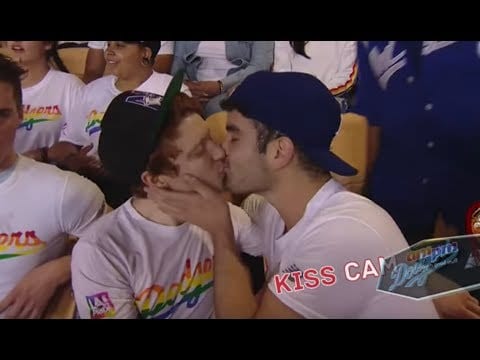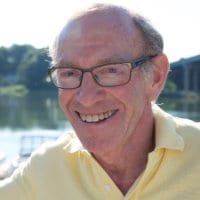Editor’s note: With the Winter Olympics around the corner and our own correspondent at the U.S. Nationals for Figure Skating, we’ve been concentrating on sports this week. And here’s our Year in Review Sports column from contributor Dan Woog… and it’s also his last column for us.
In the beginning, there was nothing. If you were an LGBT athlete, coach or fan, you were on your own. You had no idea there were others like you anywhere in the sports world. You thought you were alone. Though men and women were coming out in every other area — politics, entertainment, even the military — the locker room door remained firmly shut. Over the course of a couple of decades, of course, that’s changed. There are now countless ways for LGBT people to connect with, learn from, be inspired by, and in turn inspire others. To commemorate what is the final sports column author Dan Woog is writing for us (see below), he did a more-than-year-in-review story — a “state of the affairs” recap of some of the biggest groups and developments in sports — some famous, and some you may never have heard of. (Also, check out our year in review in the arts, culture and sports, as well as music and books, in today’s print and online editions; our recaps of film, television, stage and news are also online.)
The granddaddy of all is Outsports. Since 1999, its website (www.outsports.com) has covered the LGBT sports world with a keen, insightful eye. Its bread-and-butter is coming-out stories (everyone from Michael Sam to obscure NAIA water polo players) and news (like lawsuits alleging discrimination, and teams hosting Pride nights). In 2017, reading about athletes coming out may seem like the same-old, same-old… until you realize that it’s a new experience for the person telling the tale. And no matter what sport you play, overcoming adversity never gets old.
The Gay Games have been held every four years, since 1982. They’ve grown into a worldwide sporting and cultural event, open to all without regard to sexual orientation. Like Outsports, the concept can seem dated — until you see the power in numbers at one of the quadrennial events. The next Gay Games are set for this coming August, in Paris. Yes, gay Paree.
GLSEN — the national organization working to make K-12 schools safe, affirming places for all students regardless of sexual orientation or expression — sponsors Changing the Game. The sports project offers resources for student-athletes, coaches, phys. ed teachers and parents. As anyone who has spent any time in any school knows, the attitudes of coaches and players goes a long way toward determining the environment of the building.
Resources are also available from It Takes a Team. That project — sponsored by the Women’s Sports Foundation — works on eliminating homophobia in sports. And, true to its “team” concept, it focuses on men as well as women.
 The National Center for Lesbian Rights has a Sports Project that addresses legal issues. The organization has done landmark work assisting coaches who have been fired, as well as with coaches who demonstrate anti-LGBT behavior.
The National Center for Lesbian Rights has a Sports Project that addresses legal issues. The organization has done landmark work assisting coaches who have been fired, as well as with coaches who demonstrate anti-LGBT behavior.
Equality Coaching Alliance is an online forum. Operating primarily through Facebook, it provides a safe space for coaches to ask for – and receive – advice about being out (or not) in the workplace.
Also online: the Gay and Lesbian Athletics Foundation. The group works to enhance the visibility of LGBT athletes as positive role models.
Many groups working in the LGBT sports space involve allies. You Can Play was founded by Patrick Burke to honor his brother Brendan. The Burkes are a noted hockey family; Brendan, a gay man, showed Patrick what the locker room is like for LGBT athletes. You Can Play has posted scores of inspiring videos, filmed by high school, college and professional teams, and entire athletic departments and leagues. All deliver the same message: Anyone who can play a sport is welcome.
Another important group is Athlete Ally. Founded by University of Maryland wrestler Hudson Taylor, the non-profit provides public awareness campaigns, educational programming and resources to foster inclusive sports communities. The program includes “ambassadors” from over 80 colleges, and more than 100 professional athletes.
The proliferation of LGBT organizations has reached into the top levels of pro sports. In 2014, Major League Baseball became the first big-time sport to appoint an “ambassador for inclusion.” Former player — and openly gay man — Billy Bean provided guidance and training to players, managers and team and league staffers on LGBT issues, in the minor leagues as well as majors. He developed training programs to fight sexism and prejudice, as well as homophobia. Earlier this year, Bean was promoted to vice president and special assistant to commissioner Rob Manfred.
Two months ago, the NFL launched a Pride initiative. Part of the Diversity Council — and originated by two gay league employees — its aim is to “heighten sensitivity to the LGBTQ community (and reinforce) commitment to an inclusive environment in which all employees are welcome.”
That’s several steps beyond what professional teams in all sports have done: promote “Pride” events. Sure, they’re a way to sell tickets. But, done with creativity — as when the Los Angeles Dodgers highlight gay couples on their Kiss Cam — they’re also a way to celebrate LGBT fans who buy those tickets.
We’ve come a long way from the days when “LGBT sports” was an oxymoron. But the fact that so many initiatives exist means we’ve still got a ways to go.
— Dan Woog
Dan Woog’s parting letter:
 Dear readers,
Dear readers,
More than 10 years ago, I wrote my first OutField column. The goal was to offer a mix of stories: national events and trends; profiles of athletes, from high profile to unknown, in sports ranging from major to obscure. I had lots of ideas. I could interview then-NFL commissioner Paul Tagliabue about how having a gay son helped him become a PFLAG dad. I’d examine whether the Gay Games were still relevant. I’d look at how pro teams handled diversity training, offer a tribute to a gay former college football player who’d recently died of complications relating to a botched suicide attempt, and figure out why the world needed the “National Gay Golf Association.”
Some of those ideas panned out. Others flamed out.
In the decade since, I’ve mined the LGBT sports world. I covered Nike’s foray into diversity and inclusion — including sponsoring several annual summits, with activists and advocates from around the country — as well what happened after the company pulled back. I’ve reported on a gay surfers’ organization, and a gay ping-pong league (who knew?).
I’ve profiled an astonishing array of outstanding men and women (and some who identify as both, or neither). Lesbians climb in the boxing ring. Bisexuals swim, run and row. Transgender folks play basketball. Gay men figure skate. (Stop the presses on that last one! In fact, the hook for that story was about fighting stereotypes, not feeding into them… as I just did.)
When I started writing The OutField, LGBT athletes were relatively rare. Oops! That’s a statement you’d have heard in the mainstream media. We actually were everywhere; it was out LGBT athletes who were hard to find. Not anymore. In the past decade, the trickle of competitors who came out to teammates, coaches and (just as importantly) opponents moved from a trickle to a stream. Now it’s a geyser.
First in college sports, and today in high school, coming-out stories are commonplace. Outsports (mentioned above) can scarcely keep up. From the Ivy League and Big Ten to small Christian conferences, on the liberal coasts and in the conservative heartland, every day brings another out athlete. Their tales have an almost boring sameness. “I was so scared to come out. I worried what everyone would think. I didn’t want to lose my sport. But no one cared. Now I’m so happy!” Over and over again, that’s the story line.
But the repetition is key. Coming-out reports inspire athletes still in the closet to take what seems like a very bold step. The fact that these stories continue to be told says something about the culture of sports. It’s a changing culture I’ve been honored to report on for the past decade.
The locker room is not the only place where sports culture has evolved. It’s apparent in the front offices of teams, and entire leagues, from Major League Baseball (see above) to the National Football League to “Pride Nights” — once a marketing tool introduced with great trepidation by pro teams in cities like San Francisco and Los Angeles (see all those above, too).
A decade of writing The OutField has strengthened my friendships with LGBT sports pioneers like Pat Griffin and Helen Carroll. For longer than most of today’s athletes have been alive, these women have worked fiercely to make the sports world open and accepting to all. They’ve expanded their reach from the usual suspects — coaches and athletic administrators – to areas once thought untouchable. The column I wrote on a meeting Pat and Helen organized with representatives of LGBT and faith-based organizations was one of my favorites.
A decade of The OutField has been fulfilling and inspiring, hopefully as much to readers as to me. Our LGBT sports world is in good hands. Which is why this is my last column. I do lots of other things besides writing once a month here: I’m an openly gay high school soccer coach, and am very active in our United Soccer Coaches’ national advocacy work, to name two. I’ll continue with all that.
At the same time, I’ll enjoy watching our great LGBT sports world from the stands.
Best wishes, Dan











